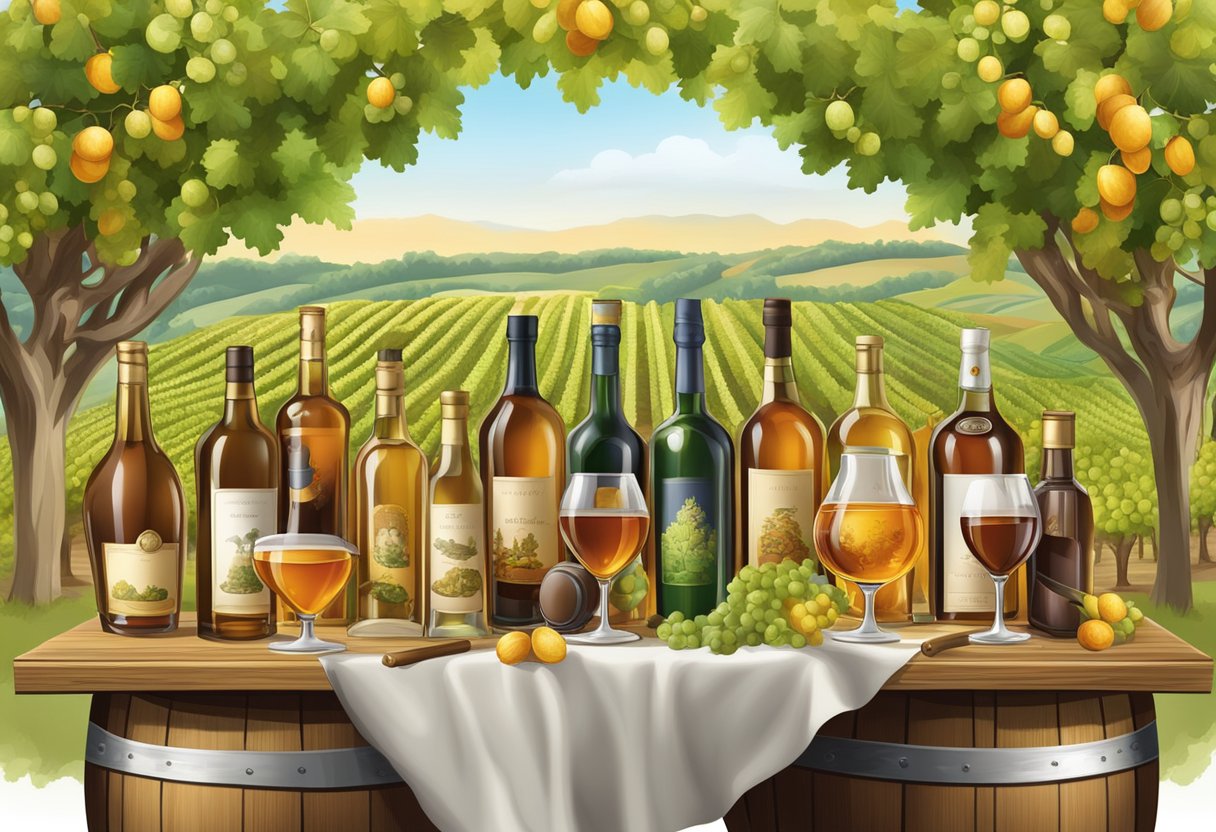Types Of Brandy
Brandy is a distilled spirit that is made from wine, which is then aged in oak barrels to produce a complex and flavorful drink. The history of brandy can be traced back to the 16th century, when wine was first distilled in France to create a spirit that could be stored for longer periods of time. Today, brandy is enjoyed all over the world and is available in a wide variety of styles and flavors.
There are many different types of brandy available, each with its own unique characteristics and flavor profile. Some of the most popular types of brandy include cognac, armagnac, calvados, and grappa. Each of these types of brandy is made using different methods and ingredients, resulting in a wide range of flavors and aromas.
When it comes to selecting and purchasing brandy, there are several factors to consider. These include the age of the brandy, the type of grape used to make it, and the region where it was produced. Tasting and serving brandy is also an important part of the experience, and there are many different ways to enjoy this delicious spirit.
History and Origin

Brandy has a rich history that dates back centuries. The origins of brandy are tied to the development of distillation. While the process was known in classical times, it was not used for significant beverage production until the 15th century. Brandy is a spirit distilled from fermented fruit juice or mash (wine, in other words). The resulting drink, however, defies such simple explanations; this is only where the story begins.
Evolution of Brandy
Brandy began to be distilled in France circa 1313, but it was prepared only as a medicine and was considered as possessing such marvelous strengthening and sanitary powers that the physicians named it “the water of life,” (l’eau de vie) a name it still retains. The Cognac region of France is particularly well-known for its brandy production. Cognac is a type of brandy that is made from white wine grapes grown in the Cognac region of France. The brandy is distilled twice and then aged in oak barrels for at least two years.
The Moors are credited with introducing distillation to Europe in the 8th century, and it was the medieval monks who were responsible for developing the distillation process and using it to produce medicinal spirits. The process of distillation was further refined over the centuries, and by the 16th century, commercial distillation of brandy from wine had begun.
Global Influence
Most wine-producing countries also make brandy. In Russia, brandy is known as “cognac” and is produced in the same way as French cognac. The United States also has a long history of brandy production, with California being the largest producer. Other countries that produce brandy include Spain, Portugal, Italy, and Germany.
In conclusion, brandy has a rich history that spans centuries and is enjoyed by people all over the world. Its evolution over time has resulted in a variety of different types of brandy, each with its own unique characteristics. From its origins in France to its global influence, brandy has truly become a beloved spirit enjoyed by many.
Types of Brandy
Brandy is a distilled spirit made from fermented fruit juice or wine. The most popular types of brandy include Cognac, Armagnac, Calvados, Pisco, Brandy de Jerez, and Fruit Brandies. Each type has its own unique characteristics that make it distinct from the others.
Cognac
Cognac is a type of brandy that is made in the Cognac region of France. It is distilled twice in copper pot stills and aged in French oak barrels for a minimum of two years. Cognac is known for its rich, complex flavor and is often enjoyed neat or in cocktails.
Armagnac
Armagnac is a type of brandy that is made in the Armagnac region of France. It is distilled once in a column still and aged in oak barrels for a minimum of one year. Armagnac has a more rustic flavor than Cognac and is often enjoyed as a digestif.
Calvados
Calvados is a type of brandy that is made in the Normandy region of France. It is made from apples and is aged in oak barrels for a minimum of two years. Calvados has a fruity, apple flavor and is often enjoyed as an aperitif or in cocktails.
Pisco
Pisco is a type of brandy that is made in Peru and Chile. It is made from grapes and is distilled to proof, meaning that no water is added after distillation. Pisco has a light, fruity flavor and is often enjoyed in cocktails.
Brandy de Jerez
Brandy de Jerez is a type of brandy that is made in the Jerez region of Spain. It is made from white wine and is aged in oak barrels that previously held sherry. Brandy de Jerez has a nutty, spicy flavor and is often enjoyed as a digestif.
Fruit Brandies
Fruit brandies are made from a variety of fruits, including apples, pears, plums, and cherries. They are distilled to capture the essence of the fruit and are often enjoyed as a dessert or digestif. Some popular fruit brandies include apple brandy, pomace brandy, grappa, and eaux-de-vie.
In conclusion, brandy is a diverse spirit with many different types and flavors. Whether you prefer the rich complexity of Cognac, the rustic charm of Armagnac, or the fruity sweetness of Calvados, there is a type of brandy for every palate.
Production and Aging
Brandy is a spirit that is produced through the distillation of fermented fruit. The most common fruit used in brandy production is grapes, but other fruits like apples, pears, and peaches can also be used to make brandy. The distillation process involves heating the fermented fruit in copper pot stills to separate the alcohol from the water and other impurities.
Distillation Process
The distillation process is a crucial step in brandy production as it determines the alcohol content and the flavor profile of the spirit. The fermented fruit is heated in a copper pot still, which separates the alcohol from the water and other impurities. The alcohol vapors are then condensed and collected, resulting in a clear liquid with a high alcohol content.
Aging Process
After distillation, brandy is aged in oak barrels for several years to develop its unique flavor and aroma. The aging process is essential as it allows the brandy to interact with the oak barrels, which imparts flavors of vanilla, caramel, and spice to the spirit. The longer the brandy is aged, the more complex its flavor profile becomes.
The aging process can be done using the Solera system, which involves blending brandies of different ages to achieve a consistent flavor profile. The Solera system involves a series of barrels, with the oldest brandy in the bottom barrel and the youngest in the top barrel. The brandy is then blended by taking a portion from the bottom barrel and replacing it with an equal portion of brandy from the second barrel, and so on.
In conclusion, brandy is a spirit that is produced through the distillation of fermented fruit. The distillation process involves heating the fermented fruit in copper pot stills to separate the alcohol from the water and other impurities. After distillation, brandy is aged in oak barrels for several years to develop its unique flavor and aroma. The aging process can be done using the Solera system, which involves blending brandies of different ages to achieve a consistent flavor profile.
Tasting and Serving
Flavor Profiles
Brandy is a complex spirit with a wide range of flavor profiles that can vary depending on the type of brandy and how it is aged. Generally, brandy has a fruity and subtly sweet taste, with flavor notes of oak since it is typically aged in wooden casks. The taste of brandy becomes more mellow and complex as it ages. Brandy that is less than two years old is considered unaged, while brandies that are more than two years old are considered mature.
Different types of brandy have distinct flavor profiles. For example, Cognac is known for its rich, fruity flavor with notes of vanilla and caramel, while Armagnac has a more intense and robust flavor with hints of spice and leather. Apple brandy, also known as applejack, has a crisp, fruity flavor with a hint of apple.
Serving Suggestions
Brandy is typically served in a snifter glass, which is designed to capture the aroma of the spirit. It is traditionally served neat, or without any mixers or ice. This allows the drinker to fully appreciate the complex flavor and aroma of the brandy.
However, brandy can also be used in cocktails. The Brandy Alexander, made with brandy, crème de cacao, and cream, is a classic cocktail that is rich and creamy with a hint of sweetness. The Sidecar, made with brandy, Cointreau, and lemon juice, is a refreshing cocktail with a tart, citrusy flavor. Brandy can also be used in sangria, adding a fruity and complex flavor to the traditional wine-based cocktail.
When serving brandy, it is important to consider the temperature. Brandy should be served at room temperature, as it is best enjoyed when slightly warmed by the hand. However, it should not be too warm, as this can cause the alcohol to evaporate and diminish the flavor.
Selecting and Purchasing
When it comes to selecting and purchasing brandy, there are a few things to keep in mind. This section will cover label classifications and choosing quality.
Label Classifications
Understanding the different label classifications is important when selecting brandy. The most common classifications include VS (Very Special), VSOP (Very Superior Old Pale), and XO (Extra Old).
- VS: This classification indicates that the brandy has been aged for at least two years in oak barrels. It is typically the youngest and least expensive option.
- VSOP: This classification indicates that the brandy has been aged for at least four years in oak barrels. It is a step up from VS in terms of quality and price.
- XO: This classification indicates that the brandy has been aged for at least six years in oak barrels. It is the highest quality and most expensive option.
It is important to note that some brandies may have additional label classifications, such as “Napoleon” or “Hors d’Age”. These terms are not regulated and can vary between brands.
Choosing Quality
When selecting brandy, it is important to choose a high-quality product. Look for brandies with the label “Appellation d’Origine Contr√¥l√©e” (AOC), which indicates that the brandy was made in a specific region using traditional methods.
Vintage brandies, which are made from a single year’s harvest, can also be an indicator of quality. However, vintage brandies can be expensive and may not be necessary for casual consumption.
Finally, it is important to purchase brandy from a reputable source. Look for a store or website with a wide selection of brandies and knowledgeable staff or customer service.






